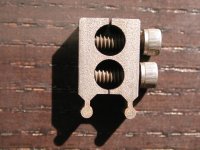nlancaster
Aluminum
- Joined
- Oct 8, 2018
Been working in the same machine shop for 3 years, and we have this one part we struggle with.
We have to finish a bore to within .0005 TIR to and OD that varies by .0005-.002 regularly.
Currently we are using a custom cut v-block style clamp to hold it, as we also cut various slots around the outside of the part.
The slots around the outside have a .005+/- range so they are super easy.
My question, would a ER style collet work or would a much more expensive 3 jaw self centering vise linked below be worth the $4k cost?
Or do you guys have another idea?
Stainless Steel Precision Three Jaw Chuck – Square .020” – 1” Capacity - BTDSQ - Hermann Schmidt Precision Workholding
We have to finish a bore to within .0005 TIR to and OD that varies by .0005-.002 regularly.
Currently we are using a custom cut v-block style clamp to hold it, as we also cut various slots around the outside of the part.
The slots around the outside have a .005+/- range so they are super easy.
My question, would a ER style collet work or would a much more expensive 3 jaw self centering vise linked below be worth the $4k cost?
Or do you guys have another idea?
Stainless Steel Precision Three Jaw Chuck – Square .020” – 1” Capacity - BTDSQ - Hermann Schmidt Precision Workholding



